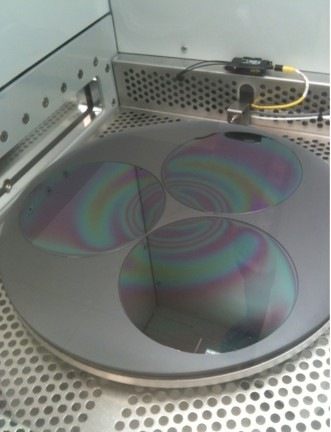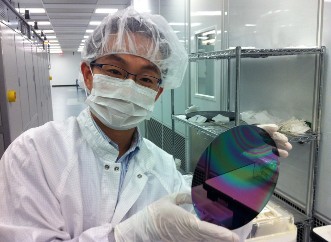Bridgelux, the trailblazer of white LEDs grown on 200 mm silicon, has recently made tremendous progress in improving device efficacy.
1.5 mm by 1.5 mm cool-white LEDs produced in the labs of the Californian outfit can now deliver 160 lm/W at 350 mA, a gain of 25 lm/W compared to the company’s best devices reported this March. What’s more, warm-white LEDs of the same size show an even bigger improvement at the same drive current – efficacy is now 125 lm/W, compared to 85 lm/W five months ago.
“The performance levels that we have announced are the highest lumen-per-Watt values yet published for GaN-on-silicon, and rival the best commercial LEDs grown on sapphire or silicon carbide,” claims Steve Lester, chief technology officer for Bridgelux.
Although the company is not giving much away regarding the secrets of its recent success, vice-president of marketing, Jason Posselt, told Compoundsemiconductor.net that improvements in the epitaxial process have helped to deliver gains in efficacy.
“We are no longer taking a sapphire recipe and trying to figure out how to grow it on silicon,” says Posselt. “We’re optimising for the silicon wafer process.” Some slight changes to packaging also led to efficacy improvements.
Thanks in part to these efforts, that latest blue LEDs - which are the foundation of making white emitters - have a forward voltage of just 2.85 V at 350 mA . “The bandgap to emit light is around 2.75 V,” says Long Yang, Vice-President of Chip Technology, “[So we are] we are only about 0.1 V above the bandgap.”
Driven at 350 mA, these blue LEDs deliver 591 mW at a wall-plug efficiency of 59 percent, and when the current is cranked up to 1 A, they produce 1.52 W at a wall plug efficiency of 47 percent. Although this indicates that the devices do suffer from LED droop, the decline in efficiency as current is increased may not be as high as it is for sapphire-based devices.
Other details of Bridgelux’s white LEDs made from these blue-emitting chips include a colour temperature of 4350K for the 160 lm/W, cool-white LED, and a colour temperature of 2940K and a colour rendering index of 80 for the 125 lm/W, warm-white emitter.
In terms of where Bridgelux’s technology stands today, the efficacy of these LEDs exceeds the company’s next-generation of warm-white LEDs on sapphire, which will deliver 120 lm/W and be released within the next 12 months. “We are seeing equivalent to - and some cases even better performance now – on silicon compared to sapphire,” says Posselt.
A substantial reduction in manufacturing cost is Bridgelux’s primary motivation for developing LEDs on silicon. The company believes switching substrates could reduce costs by up to 75 percent. The benefit of silicon is not just a cheaper substrate –processing is also far less expensive, because the epiwafers can be churned into chips at under-utilised high-throughput 200 mm fabs.
In order to tap in to this spare fab capacity, Bridgelux has to ship incredibly flat wafers to these processing partners – the bow cannot exceed 60 microns. Realising this is a challenge, because there are considerable differences in both the thermal expansion and the lattice constant of silicon and the III-Ns. To eliminate stress in the wafers, the company has developed a proprietary buffer layer.
One of the company’s latest goals is to improve the peak emission wavelength uniformity of its wafers. Engineers have fabricated wafers with a wavelength uniformity, in terms of the standard deviation, of 6.8 nm. “Our target is 3 nanometers,” says Yang.
The number of LEDs that the company is making in its R&D labs is rising fast. “Now we make these LEDs in thousands; a few months ago we made them in hundreds,” says Yang.
Sampling of products will follow, but potential customers should not expect to get their hands on Bridgelux’s silicon-based LEDs in the next month or so. “We are building prototypes of products, but this is not a tomorrow technology,” says Posselt.
According to Yang, pilot production of the GaN-on-silicon LEDs should begin within a year. Once any processing issues related to this are ironed out, Bridgelux will invest in capital equipment for the growth of the wafers in high volume. According to the company, large-scale commercial production is still two years’ away.















